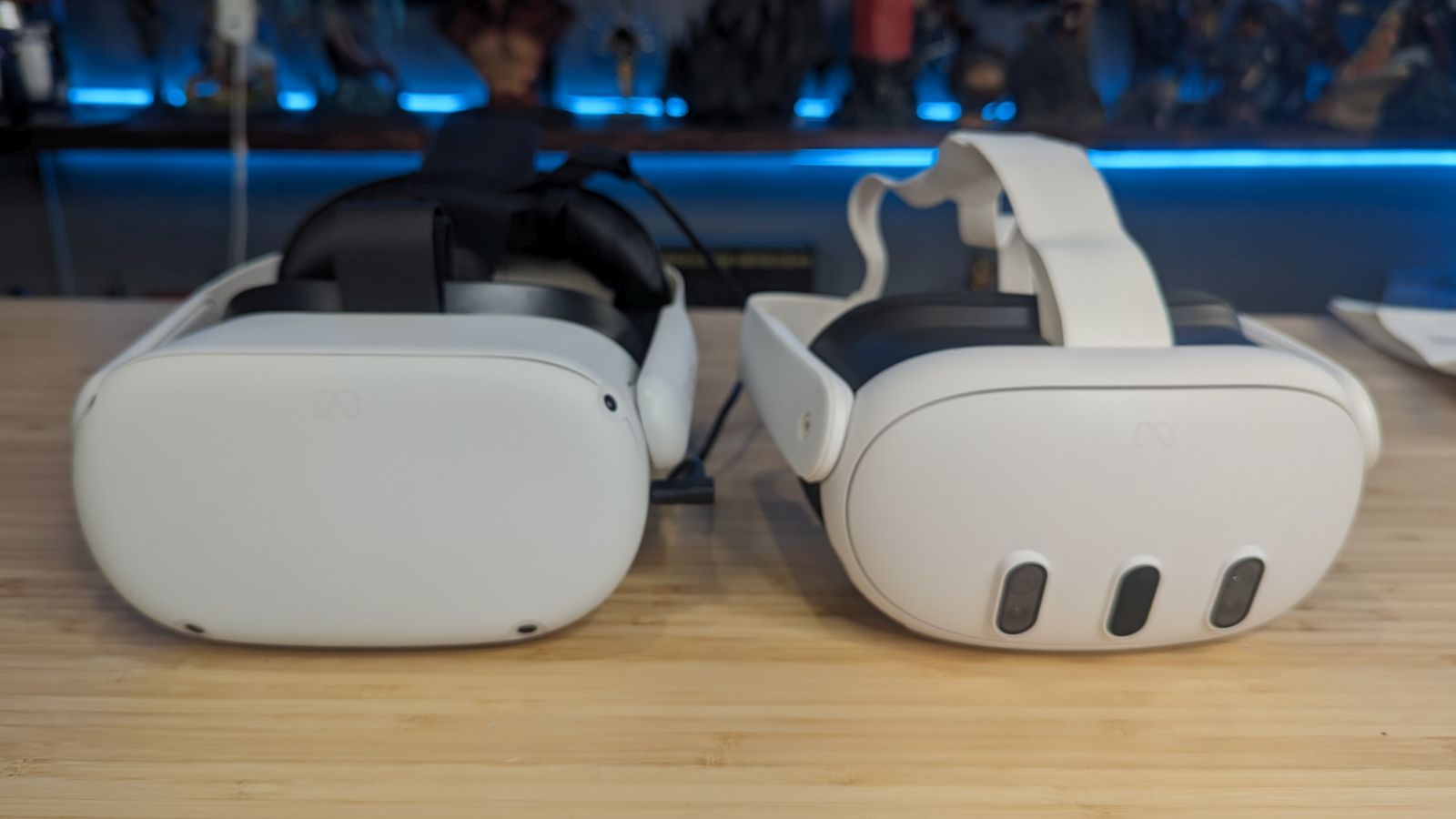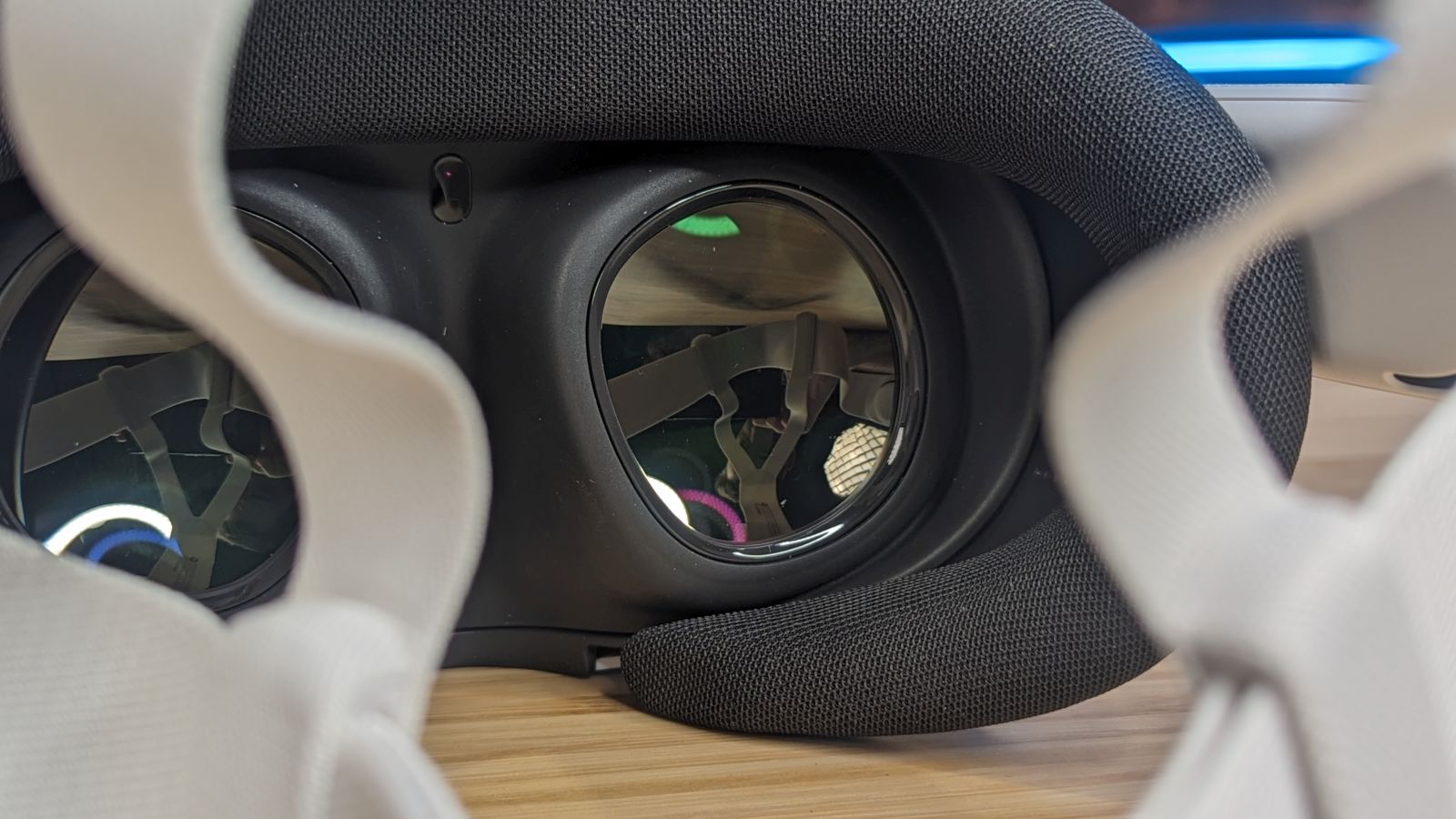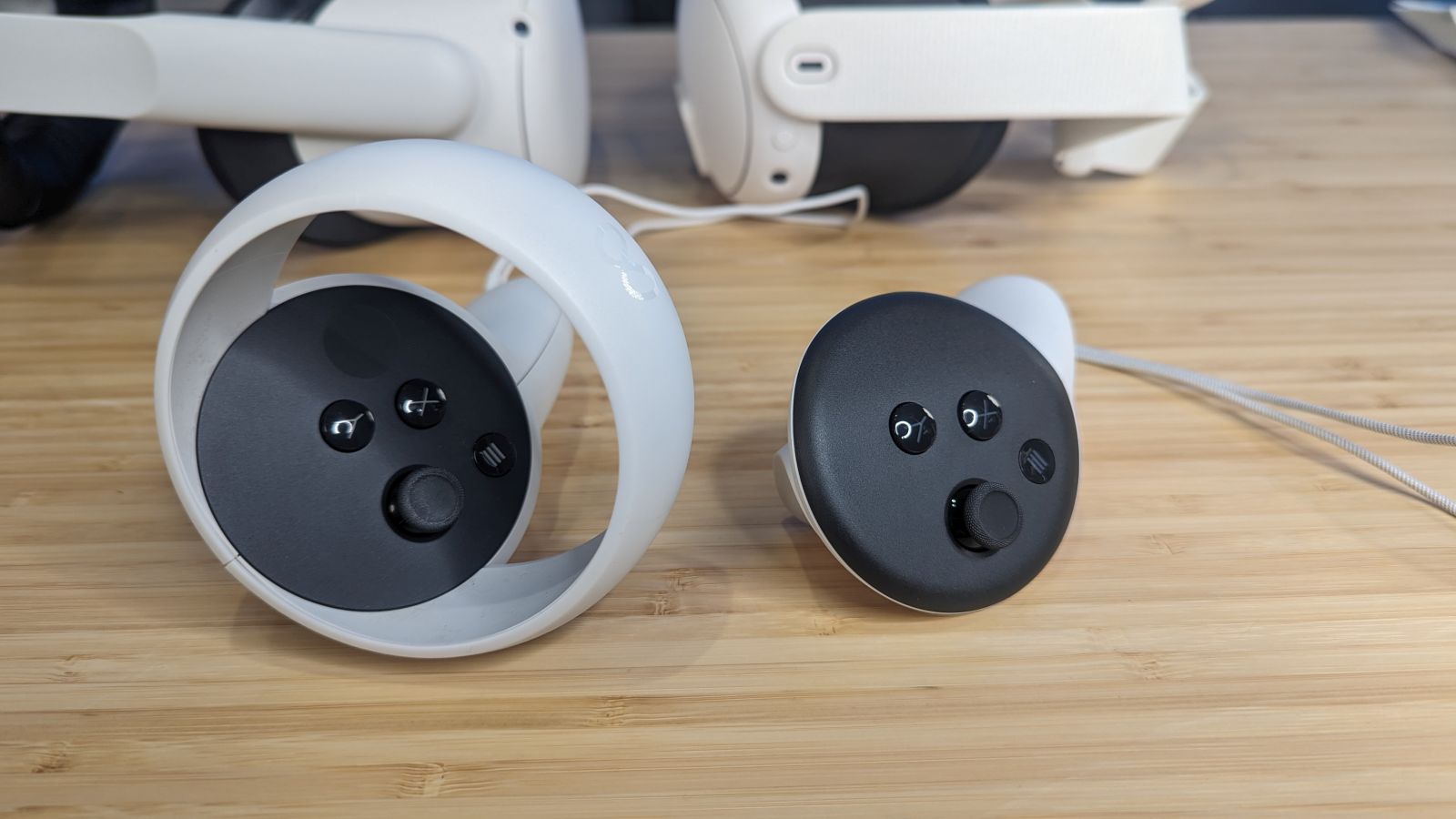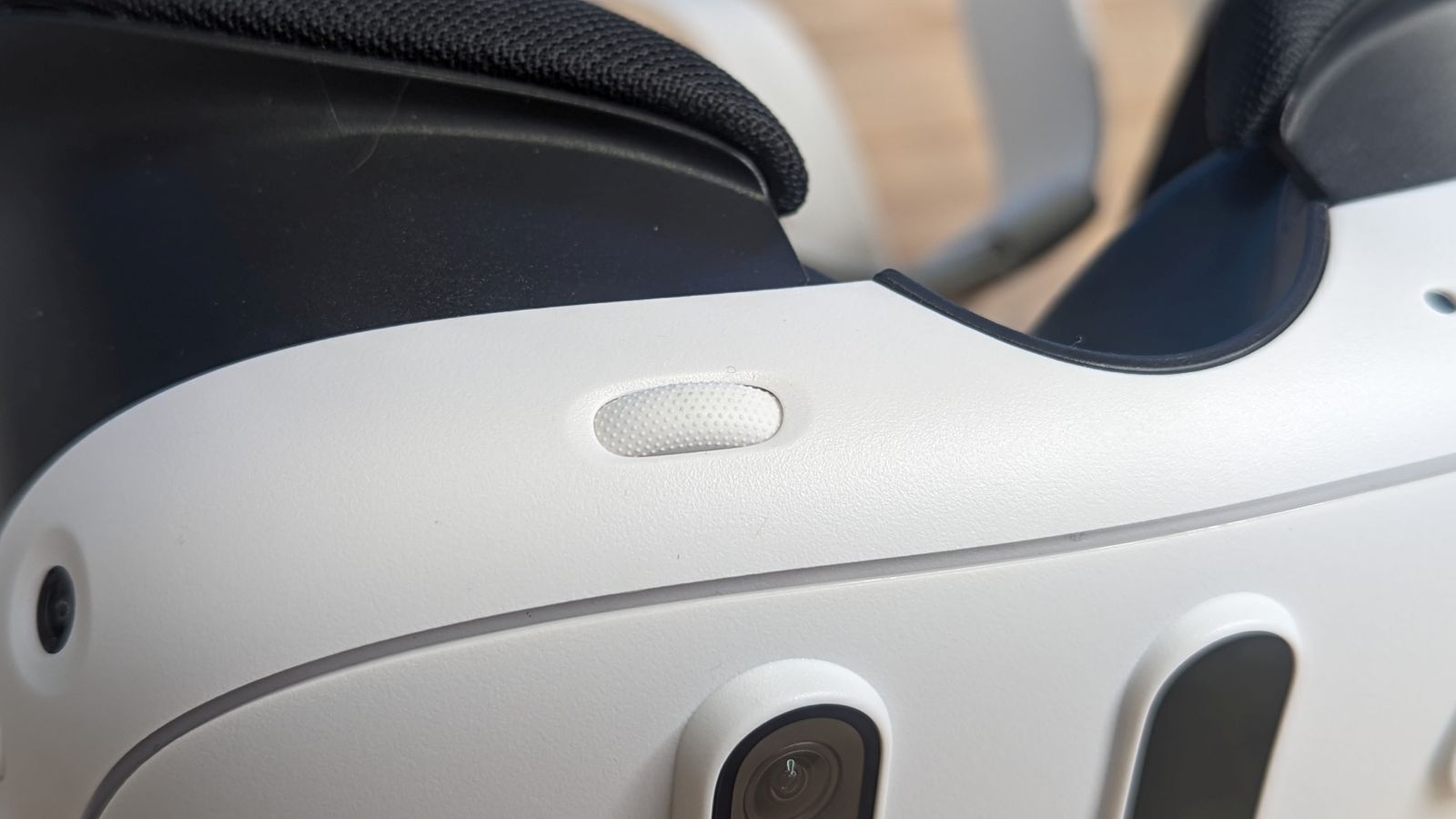It’s tough reviewing a console. You can talk about specs, you can talk about speeds, but that’s not really what people buy. No, they buy experiences. For a game console that might be an exclusive game, or a feature that causes all games to run extraordinarily fast like an NVMe drive. It could also be secondary features like legendary haptics on Sony’s DualSense controllers.
But what does that look like in VR? How can a third generation iterate on the experiences over the second without simply devolving into “It looks better and boots faster”? Well, Meta must have had this same conversation, because better looking and faster is just a very small portion of what makes the Meta Quest 3 special. Let’s put it on our face and get started.
The Meta Quest 3 has a renewed face mask. The Quest 2 had a porous soft foam mask which pretty much everyone replaced. The Quest 3’s mask is a far softer cloth one. After more than a few hours with it, I don’t think I’ll be swapping this one. In fact, I’ll likely buy additional ones so I can swap them out between users and clean them. The headset itself is seemingly smaller than the Quest 2, though that might not be immediately obvious unless you put them next to each other, and ultimately moot as it’s the weight that matters here. Specifically, the Quest 3 measures 160mm across and 98mm tall versus the Quest 2’s 142mm across and 102mm tall. In terms of weight, however, the Quest 3 is slightly heavier than its predecessor – 18.2 oz versus 17.7, to be precise. How much is that? Well, with a little bit of math and conversion, that’s a whopping eight pennies. How much does eight pennies buy you? It turns out, quite a lot.

In every way, and as you’d expect, the Quest 3 blows the Quest 2 out of the water. Let’s start with the one you probably care about most – the lenses.
The Meta Quest 2 (at launch it was the Oculus Quest 2) has lenses that are 1832×1920 resolution per eye, and up to 90 Hz refresh rate that was later patched up to 120Hz in experimental mode. The Meta Quest 3 launches at 2064×2208 resolution per eye, with 120Hz in the same experimental mode. That doesn’t sound like a significant difference but the new lenses are a massive improvement. The Fresnel lenses on the Quest 2 used concentric circles and had a nasty habit of requiring a lot of adjustments to keep them in focus. These are replaced with a “pancake lens” that drastically reduces that adjustment need, nearly eliminating the screen door effect These are the same lenses that appear in the Meta Quest Pro headset, albeit at a far, far lower price. The result is a clearer image without ghosting, glare, or reduced chromatic aberration. It’s an all around cleaner presentation.
The next tech spec is an easy one – the Quest 2 has 6GB of RAM, whereas the Quest 3 has 8GB of RAM. Frankly, this is an area where the Meta team could have jumped up dramatically, offering a full 16GB of RAM, but sadly, no. More RAM that could be spread between system RAM and VRAM would go a long way to improve game experience, but we’ll get back to that in a moment.
The Meta Quest 2 has a Snapdragon XR2 processor, and the Meta Quest 2 has a Snapdragon XR2 Gen 2 CPU. That tells you effectively nothing, but I’ve got you covered. The Gen 2 sports an 8X improvement in AI performance, which helps with hand tracking, voice recognition, and upsampling. Couple that with a 2.5X increase in GPU power and you’ve got a headset able to render extraordinarily rich and realistic graphics for VR titles. It also comes with WiFi 7 support, and enables 10 camera sensors, up from the 7 the Meta Quest 2. This is where the biggest differentiator comes in.

The passthrough on the Quest 2 was barely good enough to make sure you didn’t run into walls. The Quest 3’s passthrough is full color and high resolution, with a 12ms latency. This makes it perfect for mixed reality, or just simply navigating your space. While it’s still very nascent, it’s possible with a bit of work to play a movie off in the distance while typing on your real-world on a virtual screen in front of you, and all without losing sight of everything going on around you. You can see your kid walk up, you can pet your dog, and you can get up to grab yourself something to drink, all without taking off your headset. Sure, you’ll look like a lunatic, but you can!
In addition to the augmented reality capabilities, the Meta Quest 3 comes with Wi-Fi 7 support. Naturally you’ll need a router capable of that output, but if you happen to have one, it’ll be the most stable and fast connection you can use for streaming content to your headset. The device comes in two widely different configurations – 128GB or 512GB of storage, costing $499 and $649, respectively. Both also include a copy of Asgard’s Wrath 2 when it releases in December.
The Quest 2 would last around 2-3 hours, depending on the intensity of the application. Despite the dramatic increase in power (the GPU is roughly 2.5X of an improvement – finally, readable text!), the Quest 3 has similar battery life. Undoubtedly there will be a number of 3rd party battery headsets, but until those come out, that’s where we are.

This does, however, bring me to my largest complaint with the Quest 3 – the head strap. Meta does a fantastic job of upselling you to their better head straps. It does so by making the included ones absolutely terrible. This cloth head strap felt like a vice on my head after just a few minutes of use. After an hour, I had a headache. I will be changing this out for a new head strap as soon as humanly possible.
Speaking of charging, I’m happy to report that the Quest 3 will recharge in about 2 hours from empty to full – a huge improvement over its predecessor.
There is a subtle improvement to the Quest 3 that I didn’t immediately notice – the IPD adjustment. IPD, or interpupillary distance, is the distance between your pupils. It’s also the largest predictor of how comfortable your time in VR will be. Get it wrong and you’ll immediately know courtesy of a headache and pressure on your eyes. With the Quest 2 you had to remove the headset to adjust IPD, but with the Quest 3 there’s a small adjustment wheel. This means you can keep the headset on while you make subtle adjustments. It results in a far more dialed in experience, as the tendency was to eventually say “good enough” on the Quest 2, even if out of frustration. Subtle, but wildly appreciated.

The included controllers are another subtle but big change from the Quest 2. Gone are the tracking rings; with the additional power of the new CPU, they are no longer needed. These did provide some measure of protection for your hands and for the hardware, so be mindful of where your hands end up.
Let’s take a moment and look at the biggest change I didn’t expect between the 2 and the 3 – mixed reality. I mentioned earlier that the full-color passthrough is a huge step up, but there’s more than that. The headset now automatically maps the room, objects in it, and continues to do so as you move around. It makes mixed reality (MR) not only viable, but surprisingly fun. There are several games out already that utilize MR, and sure, you’ll look like a loon wearing this on your face while you play them, but there’s nothing stopping you from playing them in the park, your back yard, a space in your house, or anywhere in between. Low light conditions can disrupt the fun, but for the most part you can blast targets and have adventures with game overlays in the real world now. Something that has been a gimmick thus far is now suddenly a viable thing that games could be built upon.
The biggest lure of the Quest 3 is that it comes with an already-stellar library. Every game you already own works just fine on the Quest 3. In fact, if the developers put in the time, there are upgrades to be had. One example would be The Walking Dead: Sinners and Saints, which looks like a completely different game entirely on the Quest 3. Similarly, Red Matter 2 gets a massive upgrade, as does Golf+, Microsoft Flight Simulator, Dungeons of Eternity, Resident Evil 4, Into the Radius, Pavlov Shack, Broken Edge, Guardians Frontline, Holofit, Pistol Whip, Vermillion, Windlands 1 and 2, V-Speedway, and many more.
As somebody who consumes VR like an addict, there is something to keep in mind. If you want the very best possible experience, that market is still cornered by the likes of the Pimax with their incredible 12K QLED headset. Granted, you’ll also need a monster of a PC to run it, but if you’ve got both, there’s absolutely nothing like it.
The vast majority of folks don’t fall in that category, however. The PlayStation 5’s PSVR2’s eye tracking is incredibly compelling as well, providing some interesting gameplay when developers take advantage of that technology, but you have to have a PS5, and neither of those two prior examples are portable. That makes this device the top of the food chain for everything portable, and other than the eye tracking, they actually come pretty close to keeping up with the PSVR2 in terms of visual fidelity. The Meta Quest 2 dominated the market for the last generation, and the Quest 3 looks like it’ll do it again, only this time around, there’s a whole host of games and experiences ready to go at launch.
Ron Burke is the Editor in Chief for Gaming Trend. Currently living in Fort Worth, Texas, Ron is an old-school gamer who enjoys CRPGs, action/adventure, platformers, music games, and has recently gotten into tabletop gaming.
Ron is also a fourth degree black belt, with a Master's rank in Matsumura Seito Shōrin-ryū, Moo Duk Kwan Tang Soo Do, Universal Tang Soo Do Alliance, and International Tang Soo Do Federation. He also holds ranks in several other styles in his search to be a well-rounded fighter.
Ron has been married to Gaming Trend Editor, Laura Burke, for 28 years. They have three dogs - Pazuzu (Irish Terrier), Atë, and Calliope (both Australian Kelpie/Pit Bull mixes), and an Axolotl named Dagon!

It’s obvious that the Meta Quest 2’s price is very attractive, but with all the Meta Quest 3 brings to the table, I am ready to recommend it to both returning and new players alike. While I wish PCVR was a cleaner experience, it’s hard to argue against this headset for standalone play. Let’s be honest though – this head strap is garbage.
PROS
- New processor brings a 2.5X increase in power
- Dramatic improvement of visual quality with new lenses
- Fantastic improvements in tracking
- Mixed Reality is now a viable thing
- Lots of subtle, but important improvements
CONS
- This head strap is abysmal
- I’d really have liked to have seen additional battery life
- PCVR continues to be clunky
See below for our list of partners and affiliates:

























